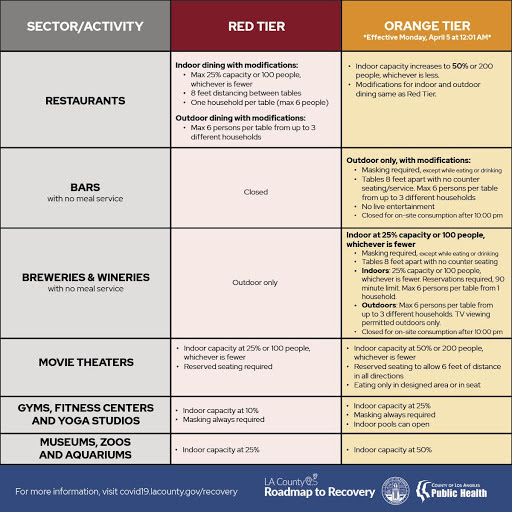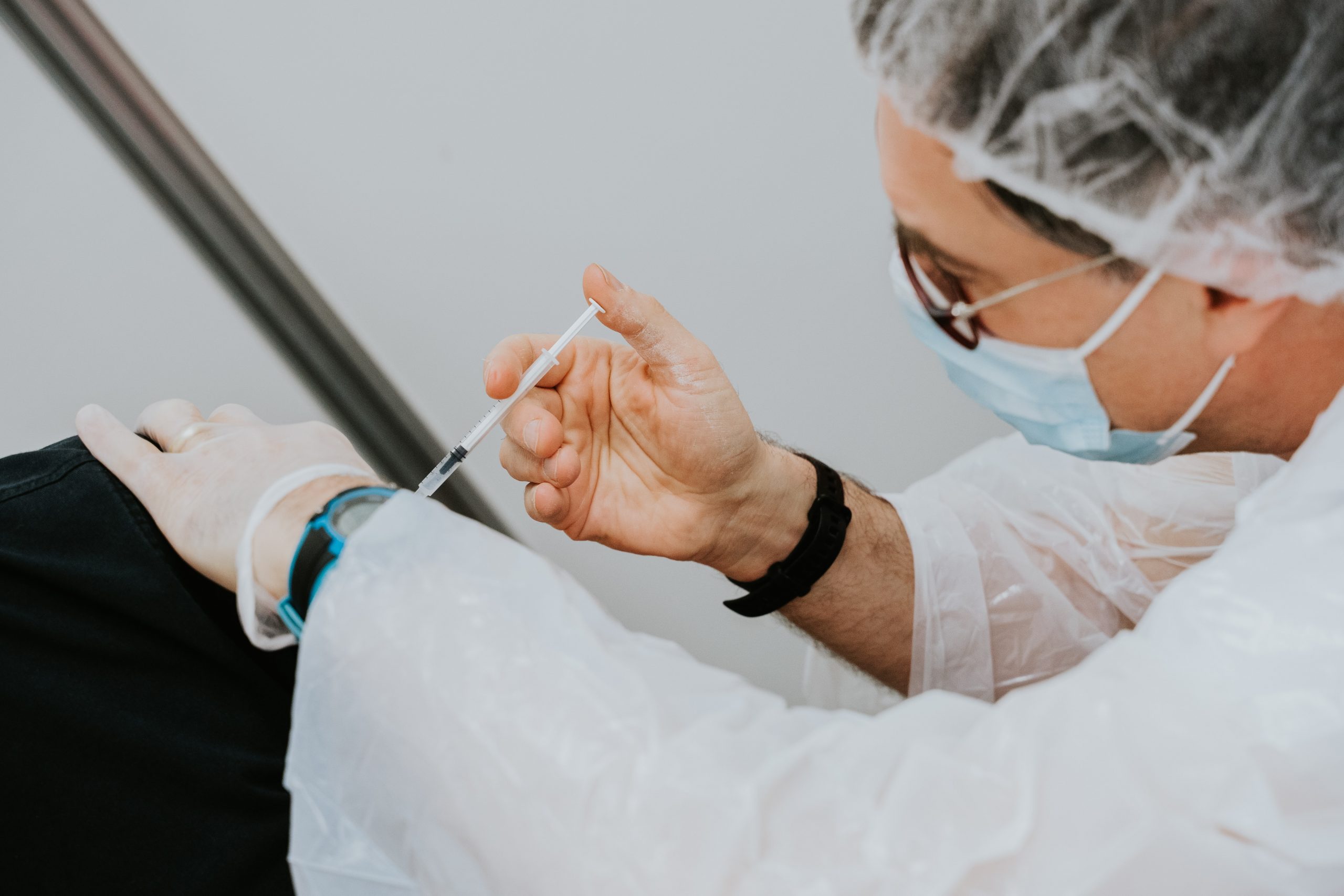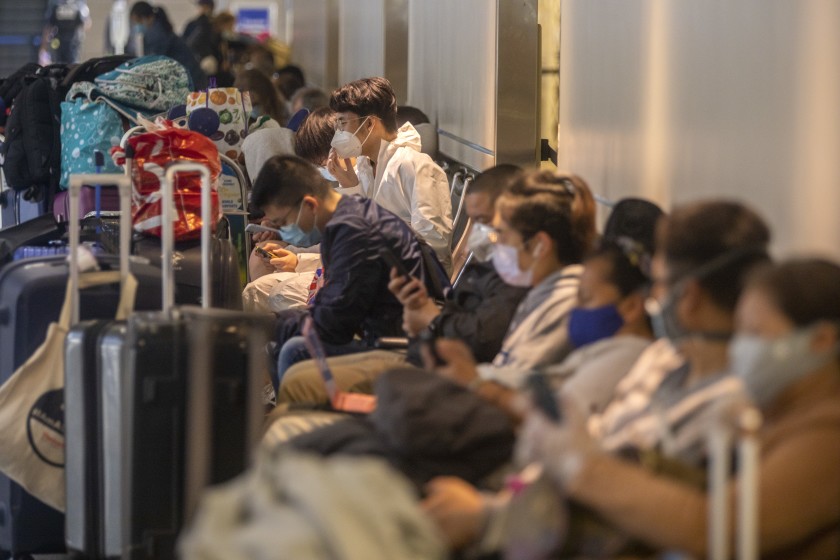Los Angeles County will enter the orange tier, indicating moderate spread of COVID-19, on Monday at 12:01 a.m., officials announced Tuesday.
According to data from the state, L.A. County’s adjusted case rate dropped from 3.7 new cases per 100,000 people to 3.1 new cases per 100,000 people. The test positivity rate dropped from 1.8% to 1.5% and in areas with the fewest resources, L.A. County’s test positivity rate dropped from 2.5% to 2.1%.
“Thanks to our collective vigilance, starting Monday more of us can now take part in more of the rituals and activities that we’ve missed — whether that means joining together, safely, in a place of worship, at the gym or visiting a museum or movie theater,” the Los Angeles County Board of Supervisors said. “We’ve come too far to let our guard down now, so please continue to follow the Public Health guidance on masking and distancing, and be sure to get vaccinated as soon as it’s your turn. We are still on a long road to recovery, and we don’t want to lose the momentum that has helped us reach the orange tier, and all it stands for in terms of enjoying a ‘new normal’ in our daily lives.”
Bars that do not provide meals will be allowed to open outdoors with distancing, masking and infection control safety measures. Indoor operations are not permitted. Masks are required except when people are eating or drinking. There can be no counter seating and people can eat or drink only when they are seated. Tables must be 8 feet apart, with a maximum of six people from up to three different households. There can be no live entertainment, television is permitted, and hours of operations are from 11:30 a.m. until 10 p.m.
Breweries, wineries, distilleries that do not serve meals can remain open outdoors and can also open indoors at 25% capacity or 100 people, whichever is fewer. These establishments will follow the same public health directives as bars for their outdoor areas. However, there are additional requirements for indoor spaces: reservations are required for indoor seating, there is a maximum of six people per table and they must be from the same household, and there is no live entertainment or television viewing indoors.
Restaurants can increase capacity for indoor dining to 50% capacity or 200 people, whichever is less with continued safety modifications.
Cardrooms can operate indoors at 25% capacity. There must be 8 feet of distancing between tables and masks are always required. Food and beverages remain banned from card tables.
Places of worship can hold services indoors at 50% capacity.
Fitness centers can operate indoors at 25% capacity and indoor pools can now re-open. Masks are always required unless swimming.
Movie theatres can increase capacity to 50% or 200 people, whichever is less. Seats must be reserved, and each group must have 6 feet of distance from other groups in all directions. Eating is allowed in only designated areas or in your reserved seat.
Family entertainment centers can open indoors at 25% capacity for distanced activities, such as bowling or escape rooms. Masks remain required.
Grocery and retail stores can increase capacity to 75%, although Public Health strongly recommends grocery stores remain at 50% capacity until April 15 so that as many grocery store workers as possible get vaccinated.
Hair salons, barbershops and personal care services can increase capacity to 75% with masks required, except for services where customers need to remove their masks. For services where customers must remove their face coverings, staff must wear a fitted N95 or a mask with a face shield.
Museums, zoos and aquariums can be open indoors at 50% capacity.
Youth and adult recreational sports can apply to the Los Angeles County Department of Public Health for approval for athletic events, tournaments or competitions that involve more than two teams or multiple individuals.
The daily average number of cases in the county is now fewer than 400 daily cases, a 50% decrease from the number of cases at the end of February. The daily average number of hospitalizations has also decreased, 52% since the end of February, and the daily average number of deaths decreased 75% in the past month.
“While Los Angeles County has yet to experience increases, this week will be critical, as we are now two weeks out from when we moved into the red tier and reopened several sectors,” L.A. County Public Health Director Barbara Ferrer said Tuesday.
Public health officials also worry that this decline won’t last as cases surge around the country and people travel to and out of the state.
“This past year indicates that often the East Coast experiences increases in cases before the West Coast and that, typically, L.A. County is a few weeks behind New York,” Ferrer said last week.
An uptick in travel as the weather gets warmer just in time for spring break season could further spread the virus.
“We know that travel is up, and I just worry that we will see the surges that we saw over the summer and over the winter again,” Centers for Disease Control and Prevention Director Dr. Rochelle Walensky said.







